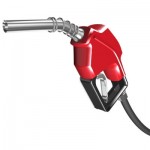 Big is back. Light trucks (pickups, SUVs, etc) outsold cars by 100,000 in the month of November—sales were up 10% from the same period in 2013 while car sales were up just 1%. Oh, and gasoline prices have been sliding all year. Coincidence? Don’t think so.
Big is back. Light trucks (pickups, SUVs, etc) outsold cars by 100,000 in the month of November—sales were up 10% from the same period in 2013 while car sales were up just 1%. Oh, and gasoline prices have been sliding all year. Coincidence? Don’t think so.
And gas prices may have some distance to fall, even if crude oil prices stop their descent: Crude is down nearly 40% from its 2013 average while gasoline prices have dropped only about 25%.
 Don’t you love the low gas prices? Filled my little car’s tank for under $30 for the first time in, oh, forever. Actually, it only feels that way. Today’s prices are roughly where they were in 2010. Isn’t it interesting how quickly we adjust to new prices?
Don’t you love the low gas prices? Filled my little car’s tank for under $30 for the first time in, oh, forever. Actually, it only feels that way. Today’s prices are roughly where they were in 2010. Isn’t it interesting how quickly we adjust to new prices?
That’s why this is the perfect time to pass a carbon tax—a tax on energy that is based on the carbon content of the fuel stock (burning coal is taxed at a higher rate than burning oil, which is more expensive than burning natural gas). After all, we’ll need to tax SOMETHING to fund highway and transit maintenance. And a carbon tax has another advantage: Instead of a complex set of incentives to do something—e.g. cut carbon emissions, invest in alternative fuels—we increase the cost of what we want people to do less. Burning fossil fuels imposes social costs that are “free” in today’s market.
 The Federal Highway Trust Fund is broke—the Federal Transportation Administration has put highway and transit funding on a cash basis, i.e. we’re spending money only as it’s earned by the tax. Why did the Fund run out of gas? The motor fuel tax has been stuck at 18.4¢ since 1993. Note that this is ¢ (cents!) not % (PERcent). Prices went up 50% in the decade before 1993, so Congress can hardly claim ignorance of inflation. And cars are getting better gas mileage, partly due to other laws passed by Congress. Average fuel economy for new cars is up 26% since 1993. Compounding the Fund’s woes, we’re actually driving less. Although total miles driven grew 35% from 1993 to 2008, since then miles traveled has actually slid about 2%. Until personal aircraft or hovercraft get a lot cheaper, we have to maintain our roads and bridges. The motor fuel tax is a “good tax” inasmuch as it maintains a connection between drivers and the cost of maintaining the roads they use.
The Federal Highway Trust Fund is broke—the Federal Transportation Administration has put highway and transit funding on a cash basis, i.e. we’re spending money only as it’s earned by the tax. Why did the Fund run out of gas? The motor fuel tax has been stuck at 18.4¢ since 1993. Note that this is ¢ (cents!) not % (PERcent). Prices went up 50% in the decade before 1993, so Congress can hardly claim ignorance of inflation. And cars are getting better gas mileage, partly due to other laws passed by Congress. Average fuel economy for new cars is up 26% since 1993. Compounding the Fund’s woes, we’re actually driving less. Although total miles driven grew 35% from 1993 to 2008, since then miles traveled has actually slid about 2%. Until personal aircraft or hovercraft get a lot cheaper, we have to maintain our roads and bridges. The motor fuel tax is a “good tax” inasmuch as it maintains a connection between drivers and the cost of maintaining the roads they use.
Most of us are convinced that we should be weaning ourselves off fossil fuels. Between direct incentives and a powerful push from $3+ gasoline prices, we’ve made significant progress in fuel economy and alternative fuels. Ford has put millions of dollars behind an effort to improve fuel economy for the world’s best-selling pickup, the F150. Its 2015 truck has shed 700 pounds (nearly a third of the total weight of what I drive!). Along with engine tweaks, Ford is promising a fuel economy boost of 20%.
Alternative fuels ![]() are getting cheaper, too. On the home front, the efficiency of solar photovoltaic has improved dramatically in the past few years with the cost of installed solar PV dropping 15% per year. Optimists are projecting “parity” with the cost of natural gas in the very near future—perhaps 5-10 years. If you had any doubt that solar PV is going mainstream, IKEA has been selling solar panel kits in the U.K. this year and has announced plans to expand to eight more countries in 2015.
are getting cheaper, too. On the home front, the efficiency of solar photovoltaic has improved dramatically in the past few years with the cost of installed solar PV dropping 15% per year. Optimists are projecting “parity” with the cost of natural gas in the very near future—perhaps 5-10 years. If you had any doubt that solar PV is going mainstream, IKEA has been selling solar panel kits in the U.K. this year and has announced plans to expand to eight more countries in 2015.
Solar PV prices have been falling for reasons that have just as much to do with manufacturing capacity as with improved technology. This should remind us that demand, which facilitates scale economies in manufacturing, is a critical piece of the puzzle. A carbon tax will increase demand for clean energy sources. Watch the video of an energy symposium focusing on solar—held last year at University of Texas at Austin.
 A carbon tax can be designed to vary with the price of fuel, thus promoting energy price stability in consumer markets. This is of particular value in capital intensive sectors like transportation and energy. Ford Motor made its investment in the F150 redesign on the assumption that consumers will still care about fuel economy. Automakers worldwide have made very large capital investments based on assumptions about the balance of demand among small cars, big cars, trucks, etc. Were gas prices to fall to $2/gallon, sales of small hybrids would drop like a rock and consumers would return to trucks and fuel-hungry passenger cars. And the manufacturers would have to close one set of plants and expand another, with all the cost that comes with the changeovers.
A carbon tax can be designed to vary with the price of fuel, thus promoting energy price stability in consumer markets. This is of particular value in capital intensive sectors like transportation and energy. Ford Motor made its investment in the F150 redesign on the assumption that consumers will still care about fuel economy. Automakers worldwide have made very large capital investments based on assumptions about the balance of demand among small cars, big cars, trucks, etc. Were gas prices to fall to $2/gallon, sales of small hybrids would drop like a rock and consumers would return to trucks and fuel-hungry passenger cars. And the manufacturers would have to close one set of plants and expand another, with all the cost that comes with the changeovers.
These costly gambles are not limited to the car market. The energy sector—from oil companies to utilities—has made strategic investments based on current patterns of demand. Major swings in consumer demand for energy and energy-conserving technology are costly for consumers, not just producers, as the cost of these changes in capital-intensive production eventually show up in prices.
So my pipedream is that people who want to reinvigorate the Highway Trust Fund (which funds mass transit AND roads), climate change activists, energy-dependent businesses and consumer groups would join together to support a tax on the carbon content of energy. Let’s keep gasoline prices above $3 per gallon and put the proceeds into needed infrastructure. At this price point—particularly if we know that the price will stay at $3 or higher—alternative energy investment makes economic sense for business and will take care of itself.
I just can’t imagine trying to explain this to Congress.
January 6, 2015 POSTSCRIPT: Since this column was written in mid December, crude oil and gasoline prices have continued to fall. As I write this, the price for U.S. crude is down to $49 per barrel. And gasoline prices! The holidays took us on a road trip to the Midwest—I paid $1.76 per gallon in Columbus, Ohio. Prices at the pump in Rochester are among the highest in the nation, unfortunately.